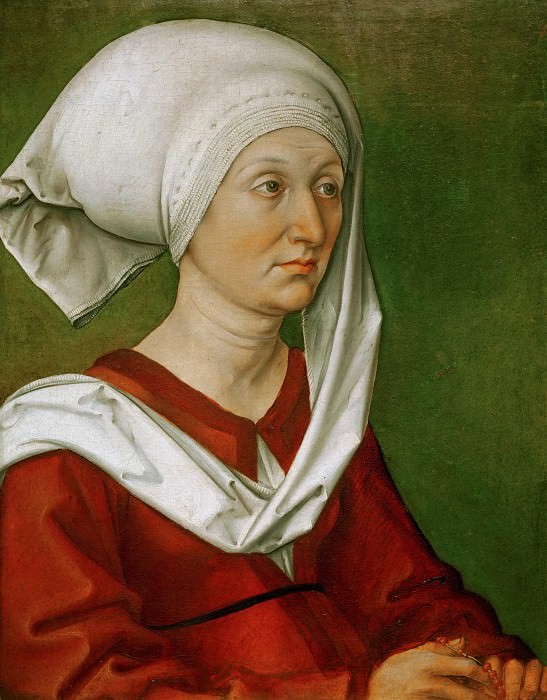Portrait of Barbara Dürer Albrecht Dürer (1471-1528)
Albrecht Dürer – Portrait of Barbara Dürer
Edit attribution
Download full size: 3855×4942 px (3,8 Mb)
Painter: Albrecht Dürer
Location: German National Museum (Germanisches Nationalmuseum), Nuremberg.
How good and almost primitive medieval portrait painting is. There seems to be nothing so pretentious, normal serious faces or cheerful or a little distorted by emotion. In this case, the artist’s mother Barbara Dürer sits before us. About the artist’s family we can say that she was the most numerous - 18 children. True, only eight have survived, but by our standards, this is quite enough. Surprisingly calm gentle face is no longer a young woman, but at the same time, she remained very attractive.
Description of Albrecht Dürer’s painting Barbara Dürer
How good and almost primitive medieval portrait painting is. There seems to be nothing so pretentious, normal serious faces or cheerful or a little distorted by emotion. In this case, the artist’s mother Barbara Dürer sits before us.
About the artist’s family we can say that she was the most numerous - 18 children. True, only eight have survived, but by our standards, this is quite enough. Surprisingly calm gentle face is no longer a young woman, but at the same time, she remained very attractive. Her hair is hidden behind a large hood, as it should be for German women. There is nothing provocative in her appearance - absolute calm. To tell the truth, she was really a beast when she was young.
But the interest is not only this portrait, but what is painted on the back. And on the back is a landscape with a cliff and a dragon. It would seem that to what? It is not immediately clear. But if you think about it, you can conclude that Durer the son wanted to tell his descendants something. Maybe there were temptations in the woman, and she might have cheated. The rock represents family, and the dragon represents adultery. Or maybe it could be interpreted this way: the dragon - death, the rock - the family, in which there were children ... But then another question arises ... There is a canvas depicting the artist’s father, and there is also a sketch on the back. But also somewhat strange - the wedding coat of arms of the Durer family. And how to explain this? Rather simply - fidelity, a symbol of loyalty. Here is a story about the parents, though full of riddles and misunderstandings...
But Dürer is known to the world not only for his paintings, but also for his graphics. His graphics are magnificent and usually on biblical themes. But there were also free themes: landscapes, animals, plants. And everything is done so realistically that one is surprised by the magnificence of the work. So that his graphics can safely be called almost better than the graphics of Da Vinci and Rembrandt. He was also passionate about geometry. Many of the formulas he derived are still being studied today.
Кому понравилось
Пожалуйста, подождите
На эту операцию может потребоваться несколько секунд.
Информация появится в новом окне,
если открытие новых окон не запрещено в настройках вашего браузера.
You need to login
Для работы с коллекциями – пожалуйста, войдите в аккаунт (open in new window).




















You cannot comment Why?
The painting is a half-length portrait of a medieval woman, identified as Barbara Dürer, the mother of the artist Albrecht Dürer. She is depicted in profile, facing to the right, against a plain, dark green background.
Barbara Dürer wears a distinctive white headdress that frames her face and drapes over her head and shoulders. Her attire consists of a vibrant red dress, visible at the neckline and sleeves, and a white cloth draped around her shoulders and chest, adding a layer of texture and contrast to the ensemble. Her skin tone is rendered with a delicate palette of pinks and ochres, and her features are finely detailed, conveying a sense of her age and character. Her gaze is directed away from the viewer, lending an introspective or perhaps observant quality to her expression. Her hands are clasped gently in her lap, and she is holding a string of beads, likely rosary beads, a common devotional item.
The subtexts of this portrait can be interpreted in several ways: